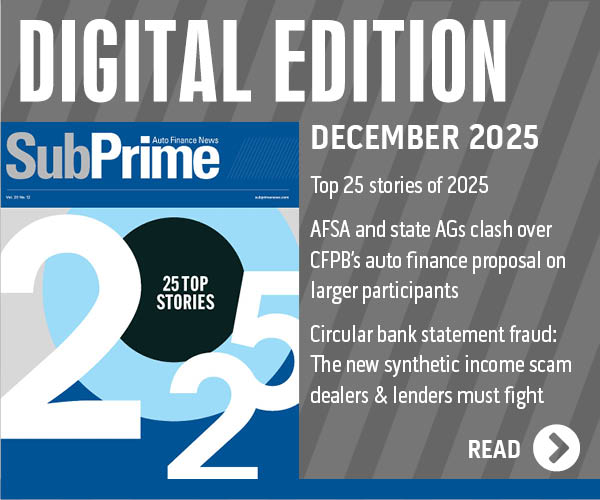Why experts are closely watching lower-income consumers in today’s economy

By subscribing, you agree to receive communications from Auto Remarketing and our partners in accordance with our Privacy Policy. We may share your information with select partners and sponsors who may contact you about their products and services. You may unsubscribe at any time.
Experts are closely monitoring what’s happening with lower-income consumers, which are often served by subprime auto finance companies.
New research from the Federal Reserve Bank of Philadelphia as well as Fitch Ratings’ expectations about asset-backed securities are two examples of observations to surface in recent days.
When examining securities on a global scale, Fitch Ratings said on Monday, “Inflation and weakening labor markets will continue to weigh on U.S. asset performance, primarily affecting subprime assets but also leading to deterioration in historically strong prime asset performance. Despite relief due to anticipated rate cuts, higher-leveraged and lower-income borrowers remain challenged by dampening real wage growth.”
Researchers at the Philadelphia Fed also touched on lower-income consumers through their latest report released on Friday. While researchers used credit-card activities as the basis of their findings, that activity might be part of the underwriting being done by auto lenders.
“For the highest tier of cardholders (those with a credit score of 720 and above), nominal average purchase volume reached a series peak in the second quarter, but after adjusting for inflation, purchase volume remains on par with its level from two years ago,” researchers wrote in their report. “This group represents roughly two-thirds of credit card accounts in the large bank data and is driving the overall trend for total average purchase volume in the large bank data series. The trends in inflation-adjusted average purchase volume for the bottom two credit score groups tell a different story.
“In real terms, cardholders in the 660–719 credit score group had a purchase volume 5.4 percent lower than two years ago, and cardholders with credit scores below 660 had a purchase volume 8.5 percent lower than that in the second quarter of 2023. These two groups are roughly equal in size and represent nearly one-third of accounts when combined,” they continued.
Subscribe to Auto Remarketing to stay informed and stay ahead.
By subscribing, you agree to receive communications from Auto Remarketing and our partners in accordance with our Privacy Policy. We may share your information with select partners and sponsors who may contact you about their products and services. You may unsubscribe at any time.
The Philadelphia Fed tried to give additional context to what that data might mean, especially as auto-finance companies consider debt-to-income ratios.
“The decline in real spending among consumers with weaker scores could reflect a greater reluctance to spend due to weaker household finances, or these borrowers could be constrained by their limited credit lines, some of which are already maxed out or close to the limits,” researchers wrote. “For the last three years, at least 10 percent of card accounts have utilized over 92 percent of their credit limit, suggesting that many borrowers may not have had the ability to spend more on their credit cards.
“Moreover, low-score borrowers have been offered smaller credit line increases than high-score borrowers, as documented by Experian,” they added.
Anna Paulson, who is president and CEO of the Federal Reserve Bank of Philadelphia, alluded to that research ahead of its release during a keynote speech at the 67th annual meeting of the National Association for Business Economics (NABE) in Philadelphia.
“With lower-income consumers more constrained, spending by high-income households may be even more important than usual. Indeed, recent analysis suggests that consumption is growing considerably faster among high-income households compared to medium- to low-income households,” Paulson said. “That means aggregate consumption growth is more dependent than usual on higher-income households.
“So, what is driving spending growth among higher income consumers? The top 20 percent of households by income own over 85 percent of corporate equity, so it is not surprising that spending by high-income households is linked to the fortunes of the stock market. And the stock market has mostly been on a tear,” Paulson continued. “However, this performance has been largely driven by just a handful of firms, and the market has been quite sensitive to the narrative around artificial intelligence (AI).
“It seems likely that AI will eventually have profound impacts on all aspects of the economy, but where we are currently seeing a lot of the action is in the stock market. This might all turn out great. And I see tremendous promise in how AI may eventually boost productivity,” Paulson went on to say. “But in the more immediate term, the relatively narrow base of support for the labor market, the importance of high-income consumers together with the prominence of the narrative around AI for equities, adds up to a relatively narrow base of support for growth over the next year or so. Indeed, some business contacts are wondering where future demand will come from. This is something to watch closely.”
The Federal Reserve also tries to watch the entire economy by maintaining dialogue with leaders of business and industry throughout its 12 districts. Comerica Bank chief economist Bill Adams and senior economist Waran Bhahirethan recapped what those leaders told policymakers earlier this fall.
“The October Beige Book — the Federal Reserve’s compilation of anecdotal information on current economic conditions across the nation — notes little change in economic activity since early September,” Adams and Bhahirethan wrote in their analysis released on Monday. “Consumer spending, particularly on retail goods, was reported to have decreased slightly. Employment held steady in recent weeks, but demand for labor was ‘muted.’
“The report noted strains in labor supply in hospitality, agriculture, construction, and manufacturing due to changes in immigration policies. Inflation persisted and picked up in some regions, which the report attributed to tariffs and higher prices of insurance, healthcare, and technology services. Some firms passed on higher costs to customers, while others absorbed them to maintain market share,” Adams and Bhahirethan continued.
Cox Automotive chief economist Jonathan Smoke offered his “bottom line” in his weekly report on Monday after looking at a variety of data points, including consumer sentiment and spending.
“Despite the uncertainty caused by the federal government shutdown and delayed official data, alternative sources confirm that the auto industry and broader economy remain on stable footing,” Smoke wrote. “Consumer spending is moderating but not collapsing, housing construction could accelerate if mortgage rates continue to fall, and used-vehicle prices are showing early signs of deflation. Lower gas prices may provide a much-needed boost to consumer sentiment and spending as we move further into the fall.”


